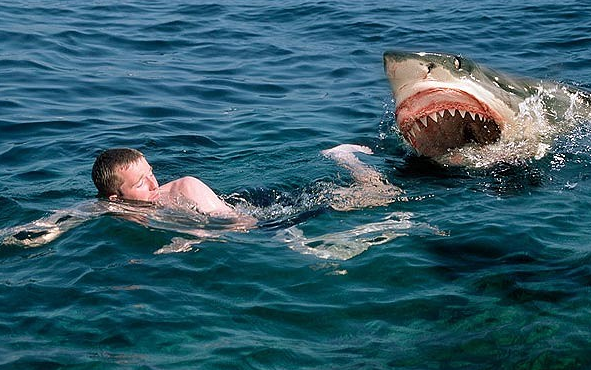Genre: Thriller/Serial-Killer
Premise: A killer exploits society’s over-reliance on mobile technology to pick off his victims one by one.
About: Today’s writing duo is one of the hottest in Hollywood. They shot onto the scene with their heavily hyped debut spec, “Die in a Gunfight” (straight out of college, no less). Unlike a lot of writers who get a sale and disappear into obscurity, they parlayed that sale into a few writing assignments, eventually landing one of the coveted Marvel projects (Ant-Man). That job has led to a job on Transformers 5. Make fun of Transformers all you want (I do) but landing a writing job on a summer franchise film is a huge freaking deal. Low Tide is a script the writing team sold to 20th Century Fox last year. This is a more recent draft.
Writers: Andrew Barrer & Gabriel Ferrari
Details: 121 pages – 3/21/15 draft
What in the sam hell?? We’ve got a sequel-free, remake-free, biopic-free, not a true story, based-on-absolutely-nothing official spec screenplay here! If I weren’t such a cynic, I’d say that we’re reviewing a piece of original fiction. It’s been so long since I’ve actually done that, I’m not sure I’m qualified to do it anymore.
The way the spec market has gone, the buyers want you to stay in HARDCORE genre lanes. Like “Bed Rest,” which sold to MGM last month. That’s a clear horror genre flick that can be marketed right out of the Final Draft box. I was just reading an article about Robert Zemeckis’s new film, The Walk, and he said that every single production company and studio in town turned the project down. When asked why, he said, simply, “It doesn’t fit into any slot, if you know what I mean.” That’s the way this business works. So for Barrer and Ferrari to go against the grain and give us an offbeat serial killer flick, you gotta give’em knuckles.
But The question that kept popping up while reading Low Tide was, how far off the beaten path can you take a genre? Did these two go too far?
30-something Shae White is not your average detective. Not only did she lose her sister in a murder-suicide when she was just a girl, but she spends her off-time going to sleazy Atlantic City hotels and banging strangers with the explicit rule-set that they tell her they love her, despite her wanting nothing to do with them afterwards. She even keeps the dirty panties from the sex-sessions in a giant drawer in her bedroom. Hash-tag naughty.
Shae is assigned to a strange case where her daughter’s future boyfriend is attacked by a shark and loses his leg. When the police go fishing for the leg, they instead find another leg, that of a recently deceased female.
When the police find the rest of the female, they learn she was murdered, but they decide not to share this detail with the public in fear of wiping out 4th of July tourist traffic on the Jersey Shore.
Shae teams up with another detective, Pete, and the two discover that a man named Robin Goodfellow is texting young women from the fake accounts of their lovers in order to lure them into murderous situations. Goodfellow is sort of a cross between Jigsaw, Scream-Villain, and Hannibal Lecter, a philosophizing recluse who enjoys playing people for chess pieces.
It isn’t long before Goodfellow begins targeting Shae, texting her and calling her with an untraceable fake electronic voice. But Goodfellow may be targeting someone above his pay grade this time. Shae gradually puts the clues together and finds our psycho recluse, leading to a showdown that will leave only one of them able to keep texting those “lol’s.”
There’s a part of me that respects what Barrer and Ferrari have done here. One of the hardest things about screenwriting is walking that fine line between embracing traditional screenwriting structure, and adding just enough messiness to keep your script unique.
This is often what leads to that coveted “voice” we hear so much about but rarely understand. The way in which you break those well-worn rules is what makes your voice different, is what makes your work feel like you. But here’s where the “fine line” thing comes in. Those detours only look good if they work. And I’m not sure they worked in Low Tide.
Right from the start, I had a hard time finding my footing. We start with a cool scene where a girl gets a spooky text from someone while with her boyfriend. The text says only, “He knows.” It turns out our girl has been unfaithful, and now she’s in an isolated area with a guy who, if the texter is to be believed, plans on harming her. So she runs, and it doesn’t end well.
We then go to a woman throwing her dirty panties into a post-sex dirty panty pantry. We then jump to a girl who may or may not be her daughter (it isn’t made clear) who watches as the boy she has a crush on gets his leg bitten off by a shark. We then watch the police fish out the boy’s leg and bring it to the hospital to be reattached, only to realize it’s a different leg. We then find the source of this different leg – the now-murdered girl from the opening.
I suppose it sort of makes sense but it was all so disjointed that 30 pages in, I still didn’t know where the script was going. Eventually our killer, Robin Goodfellow, is introduced, and he provides some connective tissue to all this madness, but Low Tide spent the majority of its tide just trying to make sense.
I mean I’m still not clear on how Goodfellow kills his victims. He doesn’t do it himself, since he stays in his little room the whole time. I guess this means he recruits others to do it. But that’s pretty far-fetched, the idea that you can recruit random people willing to partake in your weird text and fake-electronic-voice phone murders.
That wasn’t the only sloppy part. One of the ways you can tell a script’s not working is if key characters disappear for long chunks of time. This indicates the writers weren’t thinking things out ahead of time or don’t know what do with the characters. Nancy, Shae’s daughter, gets a couple of key scenes early on (saving our shark-attacked boy), and then disappears for 40 pages at a time.
I know there’s an ongoing war in the screenwriting community between outliners and non-outliners, but this is where outlining really helps. You can see exactly where characters need more time and where they don’t.
The movie inspirations here were also too heavy. The shark attack and subsequent “hidden from the public to keep profits up” storyline was ripped straight out of Jaws. The electronic voice stuff was taken straight out of Scream. And our serial killer manipulating our female lead was too similar to Silence of the Lambs.
Look, it’s hard not to include plot points and characters from our favorite movies. That’s why we became screenwriters in the first place. Because we love movies! But the way you want to approach imitation is the way actors study subjects they’re going to play. They don’t ape their mannerisms or do impressions of those people. They take the ESSENCE of the person and let it inspire their own unique performance.
Take the ESSENCE of what you see in the filmmakers and writers you enjoy and apply that to your script. Avoid applying direct plot points and characters. I particularly see this problem with young screenwriters. For whatever reason, they’re more prone to bring in stuff from the movies they love. Veteran screenwriters actively look to create their own storylines and strive to be different from their predecessors.
The good news is, these two are visual writers. They’re definitely thinking about what’s going to be up on that screen. And that’s important. A woman stalking around in a sex-dungeon wearing a half-destroyed Pinocchio mask while an electronic voice taunts her is major trailer material.
And Shae’s weird sex addiction was compelling as well. The whole insisting on people telling her they loved her, while actively avoiding love, while also keeping this bizarre panty memoir. That had me wondering what this woman was going to do next. If you can write characters that have readers turning pages because they want to know what they’re going to do next? That’s a rare talent.
But in the end, this felt too patch-work for me. And I couldn’t get over the stuff taken from other movies. These guys are definitely talented and have a unique voice. But you can’t be unique if you’re blatantly bringing other movies into your story. I’ll be interested to see what you guys thought. There’s a bit of True Detective in Low Tide’s DNA. And I know you all loved that show (me, not so much!). This cold be one of those “Carson hates, but everyone else loves” scripts??
[ ] what the hell did I just read?
[x] wasn’t for me
[ ] worth the read
[ ] impressive
[ ] genius
What I learned: Don’t write like a virgin. – There’s an old saying that pops up every once in awhile: “Kiss like a virgin.” It refers to the over-the-top, heavy lip and tongue, intense over-compensating kiss you give when you haven’t had sex yet. There’s an equivalent in screenwriting. “Write like a virgin.” This is when writers use big words, throw in a lot of heavy “look at how smart I am” philosophizing by characters, rounded up with lots of references to historic literary titans (both Twain and Nietschke get some love in Low Tide). This kind of writing, if overdone, makes the writer look insecure. The veteran pros know that it’s all about story. They don’t need to prove their worth in every line. If the sentence, “He walks over and grabs his wallet” is all that’s needed for the moment, despite it being an overly-simplistic presentation of the action, that’s what they’ll use. I wish Barrer and Ferrari would stop trying to prove how much they’ve read or studied or how many big words they can use and just write. They’re talented guys. Why all the fireworks?



